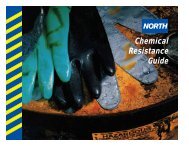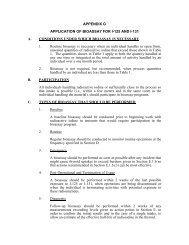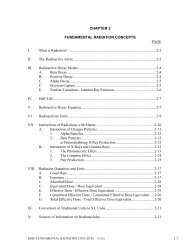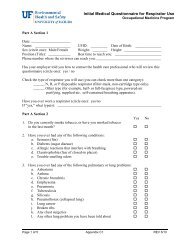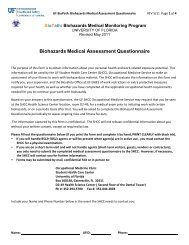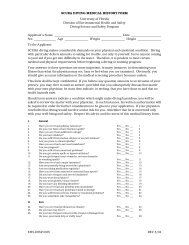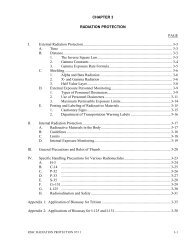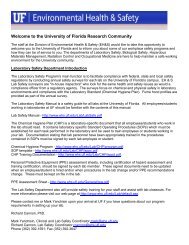Biological Safety Manual - University of Florida
Biological Safety Manual - University of Florida
Biological Safety Manual - University of Florida
Create successful ePaper yourself
Turn your PDF publications into a flip-book with our unique Google optimized e-Paper software.
ResponsibilitiesAll individuals working with or handling biohazardous materials should be committed to safety,and must demonstrate the ability to understand and follow:1. Safe work practices2. Applicable local, state, and federal requirements for work with these materials.The Principal Investigator (PI) is responsible for ensuring that all members <strong>of</strong> the laboratory arefamiliar with and adhere to safe research practices. In the clinical laboratory setting, the facultymember who supervises the laboratory is responsible for safety practices. The PI agrees to:1. Follow all local, state, and federal requirements applicable to his or her research.2. Register (and update) his or her work with the Biosafety Office and/or Institutional BiosafetyCommittee3. Inform laboratory staff and visitors <strong>of</strong> the hazards they may encounter and provideinformation on how to minimize the hazard exposure.4. Report exposures to or releases <strong>of</strong> biohazardous material to the Biosafety Office.5. Provide a safe work or learning environment.Lab managers, supervisors, technicians and others who provide supervisory roles inlaboratories and clinical settings are responsible for overseeing the safety practices inlaboratories.Employees who work with biological materials are responsible for:1. Reading this manual and understanding the contents.2. Carrying out the safety practices outlined in this manual.3. Reporting any problems, accidents, and spills to the PI or lab manager.Environmental Health & <strong>Safety</strong> will provide guidance, information, review, monitoring, andtraining regarding biosafety programs, when appropriate. This includes:1. Registering and tracking <strong>of</strong> projects utilizing biohazards.2. Evaluating work practices, safety and personal protective equipment, and facilities used forresearch or clinical activities with biohazards.3. Developing and implementing administrative controls (along with the Institutional BiosafetyCommittee) for biohazards.4. Serving as a liaison between the PI and local, state, and federal regulators.Institutional Biosafety Committee (IBC)1. Reviews and approves all experiments involving recombinant or synthetic nucleic acids.2. Works in conjunction with the EH&S Biosafety Office to establish, monitor, and enforcepolicies or procedures for work with biohazardous materials, including BSL3 and selectagents.Biosafety: Fundamentals and DefinitionsAll research projects at UF involving the following must be registered with the Biosafety Office bysubmitting the appropriate registration forms: Known human, animal, or plant pathogens or pathogenic material, BSL-2 or greater Suspected human or animal pathogens or pathogenic material Select Agents <strong>Biological</strong> toxins having an LD 50 <strong>of</strong> ≤100 g /kg body weight Primary human tumor cells Cell lines transformed with a virus “Dual Use Research <strong>of</strong> Concern” experiments7




